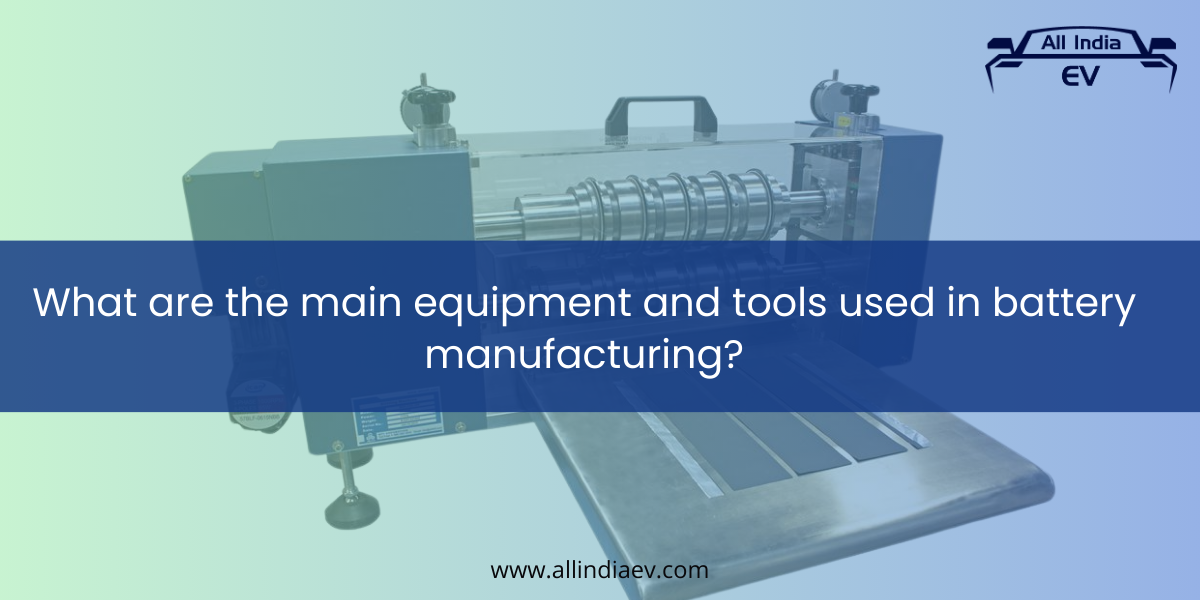
Battery Manufacturing: Equipments and tools used. A guide to the coating, slitting, winding, welding, filling, sealing, and testing machines.
As the electric vehicle (EV) industry continues to gain momentum in India, the demand for high-quality batteries has surged. Batteries are the heart of EVs, and their manufacturing process is intricate, requiring specialized equipment and tools. This article delves deep into the world of battery manufacturing highlighting the main equipment and tools used in various stages of production.
1. Coating Machines- Coating machines apply a layer of electrode material onto a metal foil, known as the current collector. This electrode material is crucial as it stores the energy in a battery.

➡️ The machine spreads a liquid mixture, called a slurry, onto the current collector.
➡️ The slurry contains active materials that store energy.
➡️ Once coated, the material is dried to leave behind a thin, uniform electrode layer.
2. Slitting Machines- After coating, the electrode rolls are too wide for individual batteries. Slitting machines cut them to the right width.

➡️ The machine uses sharp blades to cut the rolls without causing damage.
➡️ It ensures that the edges are smooth and free from imperfections, which could affect battery performance.
➡️ These are wound together in a tight roll, often referred to as a “jelly-roll” due to its appearance.
3. Winding Machines- Batteries have layers of material rolled together. Winding machines help in this process.
➡️ The machine takes the anode (positive electrode), cathode (negative electrode), and a separator (prevents short-circuiting).
4. Welding Machines- To extract energy from our “jelly-roll”, we need to connect it to the battery’s outer terminals. Welding machines make this connection.
➡️ Tabs (small metal pieces) are attached to the anode and cathode.
➡️ The welding machine securely attaches these tabs to the battery casing, ensuring a strong connection.

5. Filling Machines- Batteries need an electrolyte, a medium that allows ions to move between the anode and cathode.
➡️ The filling machine injects the electrolyte into the battery cell.
➡️ It’s crucial to ensure no air bubbles are trapped, as they can affect battery performance.

6. Sealing Machines- To ensure the electrolyte doesn’t leak and contaminants don’t enter, batteries are sealed tightly.
➡️ The machine uses heat or ultrasonic vibrations to seal the battery casing.
➡️ This seal ensures the battery’s internal environment remains stable.

7. Testing Machines– Before batteries reach our vehicles or devices, they undergo rigorous testing to ensure safety and performance.
➡️ Machines test various parameters like energy storage capacity, internal resistance, and behavior under extreme conditions.
➡️ Only batteries that pass these tests make their way to the market.

Conclusion
Battery manufacturing is a blend of art and science. Each step, from coating to testing, plays a pivotal role in ensuring the battery’s efficiency and safety. As we embrace the EV era, understanding these processes helps us appreciate the marvels of engineering that power our future.
Stay connected with All India EV for more deep dives into the world of electric vehicles and battery technologies.
Explore the Engineering Marvel of EV Industry with EV Engineering at All India EV
